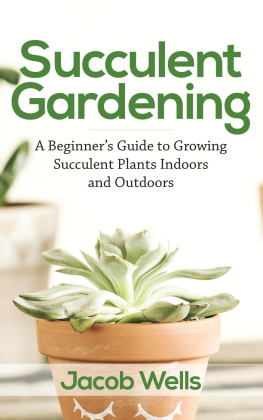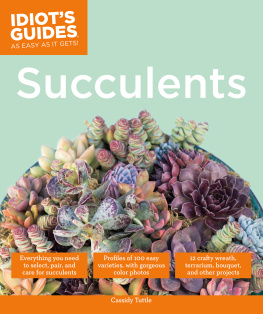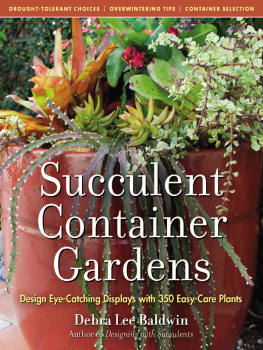The Timber Press Guide to Succulent Plants of the World


Adenium socotranum. Photo by Rob Skillin.

Copyright 2011 by Fred Dortort.
All rights reserved.
Photographs are copyrighted by the author unless otherwise indicated.
Published in 2011 by Timber Press, Inc.
The Haseltine Building
133 S.W. Second Avenue, Suite 450
Portland, Oregon 97204-3527
timberpress.com
Library of Congress Cataloging-in-Publication Data
Dortort, Fred.
The Timber Press guide to succulent plants of the world : a comprehensive reference to more than 2000 species / Fred Dortort. 1st ed.
Includes bibliographical references.
ISBN 978-0-88192-995-9
1. Succulent plantsHandbooks, manuals, etc. 2. Succulent plantsIdentification. I. Timber Press (Portland, Or.) II. Title. III. Title: Guide to succulent plants of the world.
SB438.D67 2011
635.9'525dc22
2011007949
A catalog record for this book is also available from the British Library.

For Gael


Table of Contents
Foreword
W HEN I STARTED working at the University of California Botanical Garden (UCBG) in 1998 I had the great pleasure of meeting Fred Dortort. Fred worked with the Arid House collection of succulents and cacti, the largest collection of plants in the institution, with over three thousand accessions consisting of approximately double that number of individual plants. At that point he had already been working for nearly twenty years in this living museum, with its rich representation of dry-growing plants from around the world serving as a repository for some of the planets most endangered species.
Upon meeting Fred I was amazed at his knowledge of the succulents in this large and diverse assemblage. He not only knew the names and taxonomy of seemingly all three thousand taxa, but also their individual growing habits in the wild and their growth requirements in cultivation. I felt lucky to be able to learn from such an avid and enthusiastic authority.
As I got to know Fred I became deeply impressed by not only his knowledge, but also his eagerness to expand that knowledge. Periodically he would disappear, showing up again after several weeks with stories about plant hunting in far-flung places. Tales of local encounters, including charging elephants, flash floods, and camp-site raids filled out his colorful accounts. These stories were woven into the substance of informativeand often quite exhaustivelectures for UCBG staff and volunteers. Freds slides of plants growing in their natural habitats have helped us better understand and appreciate these unique plants.
Freds enthusiasm for conveying his knowledge about these wonderful plants was apparent from the first time I met him. He took great pleasure in educating people about how succulents survive in the often-extreme habitats in which they are found. He began writing articles for the UCBG Newsletter on particular succulent genera or associated groups of plants. These abbreviated presentations, coupled with his writing for professional journals, became the germ of this book.
Seeing Freds interest and excitement for succulent plants turn into this significant book is very satisfying. A true teacher, Fred has assembled his information in a format that works for a wide audience, particularly for people who are enthusiastic and interested but not necessarily expert in succulent biology or cultivation. The many rich habitat photographs give the reader insight into how the plants grow in nature. Cultural information provides tips for successfully growing these plants at home. This is a book to be appreciated by both experts and beginners alike.
CHRISTOPHER CARMICHAEL
Associate Director of Collections and Horticulture
University of California Botanical Garden Berkeley, California
Preface
T HE FIRST TIME I visited a succulent plant nursery, I felt as if Id been handed the key to an odd but very interesting room. I saw plants there that resembled flowers, plants that looked like rocks, and plants that fit no familiar description at all. Far from the typical employees of a nursery, the people I encountered at these places, usually the owners themselves, were both extremely enthusiastic and extraordinarily knowledgeable about their plants. In my case their enthusiasm was catching.
Around the same time, I became aware of the University of California Botanical Garden at Berkeley (UCBG). I was intrigued by its scientifically organized collection of plants arrayed against a backdrop of colorful tales of travels and collecting trips as far back as the 1920s to some of the most remote places in the world. Before long I wanted to see some of these exotic places and plants myself. Armed with a paperback book on cacti and succulents, I went out to the great Southwest to look for what I did not realize were some of the rarest, most localized plants in North America.
Over the years I have managed to visit many fascinating succulent habitats. I also have developed a continuing association with UCBG, at times teaching courses there, heading the cactus and succulent propagation program, and at various intervals taking charge of the large greenhouse collections of cacti and other succulent plants. I also began a long series of articles for the UCBG newsletter as well as more formal contributions to the Cactus and Succulent Journal and other horticultural publications. The present book is a sort of culmination of these endeavors, intended for an audience I felt was under-served: interested beyond the scope of a beginner but not yet prepared to plunge into the world of botanical monographs and specialized books devoted to individual plant families and genera.
The high points in my experiences with succulent plants, however, have always taken place in the field. It is easy to recapture the wonder I felt at the first sight of a Namaqualand quartz field, where argyrodermas, looking like Easter eggs carved out of sky blue wax, grew so densely that it was almost impossible not to step on them. Or, a lonely Baja California hillside covered with centuries-old bursera trees, 5 feet (1.5 m) across and 8 inches (20 cm) tall, wafting incense into the air at the slightest touch. Or Chihuahuan Desert landscapes where the ground, composed of plates of limestone, rang like bells under my footsteps. Seeing these things made me want to let people know that, first, these places existed on our Earth, and second, these plants which we usually associate with neat little rows of square plastic pots actually are among the most extraordinarily adapted organisms in existence, perfectly suited to their otherworldly homes. If I can convey some of my wonder at the presence of such things and places to some of my readers, I will consider this book a success.
A NOTE ON THE ILLUSTRATIONS
Next page













